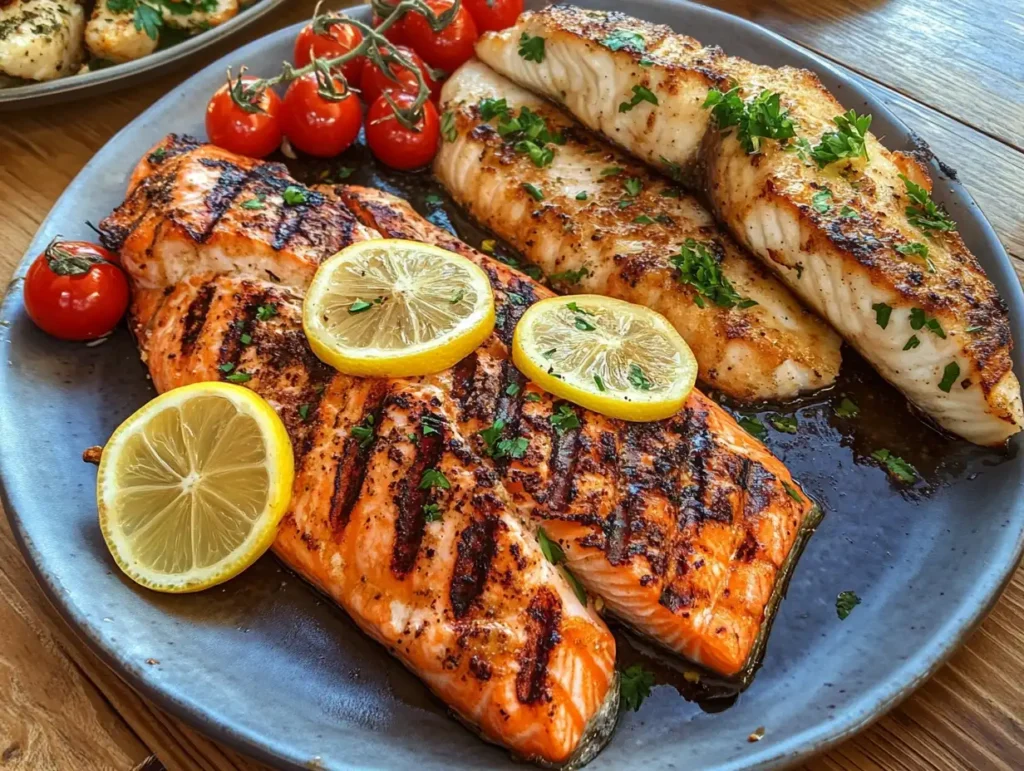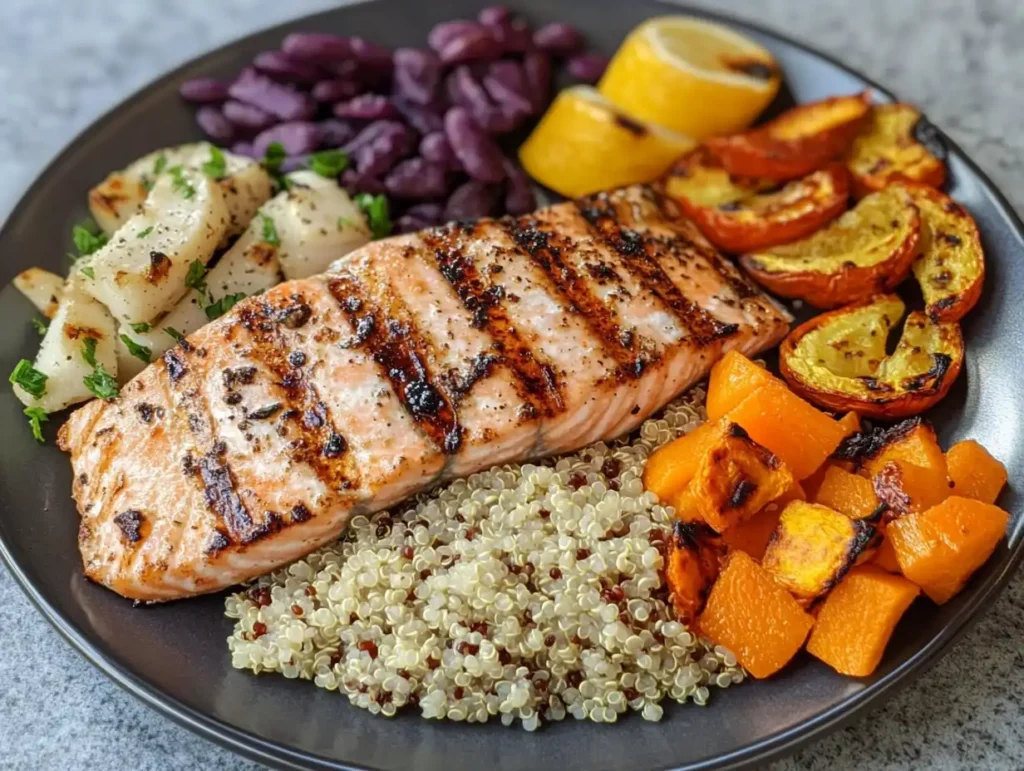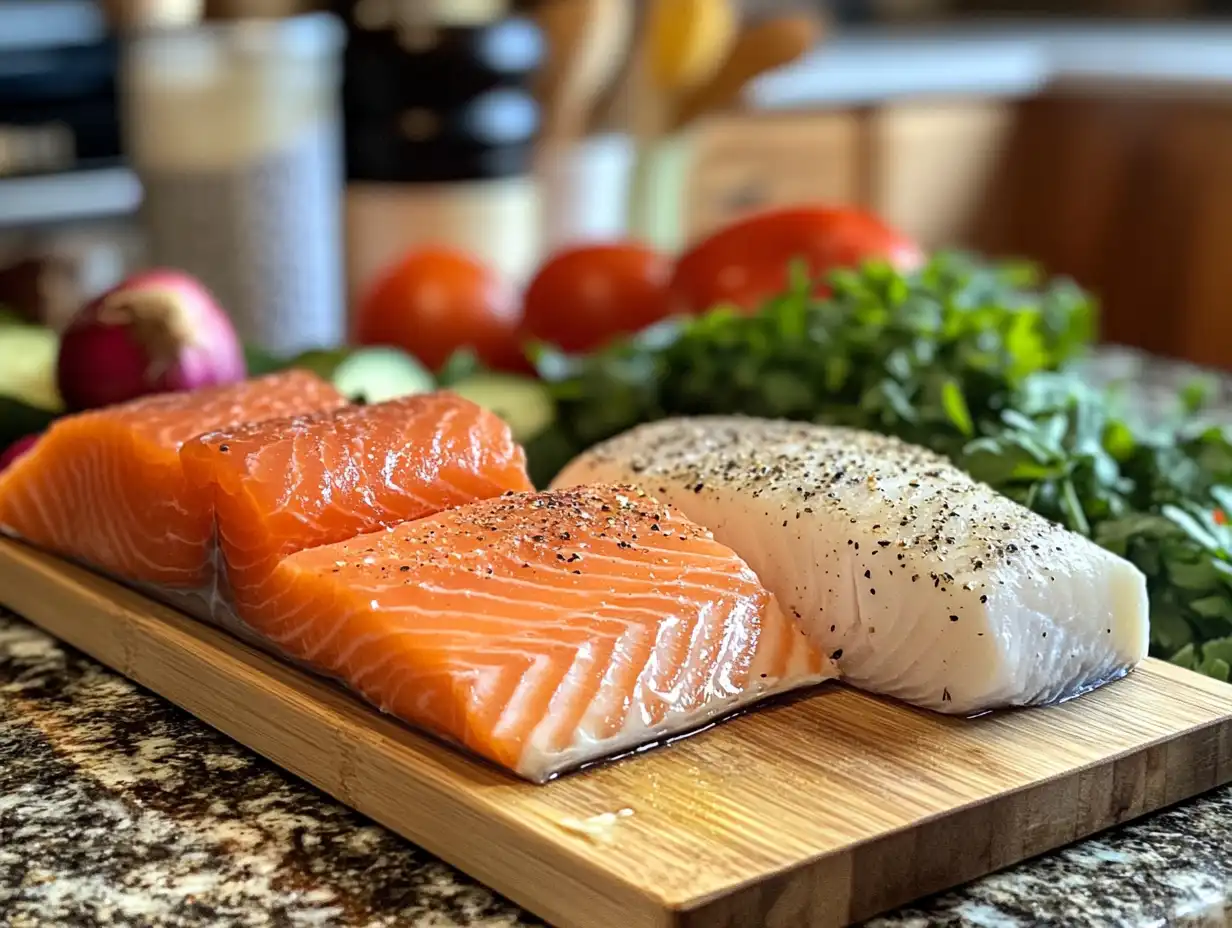Table of Contents
Introduction
When it comes to seafood, the terms “whitefish” and “salmon” are often used interchangeably by some, yet they represent distinct groups of fish with unique characteristics. Are they truly related, or is this a common misconception? Understanding the differences and similarities between these two popular types of fish can help you make better choices when shopping, cooking, or simply expanding your knowledge about aquatic life.
In this article, we’ll explore what makes whitefish and salmon unique, compare their characteristics, delve into their health benefits, and address common questions about their relationship. Let’s dive in!
Introduction to Whitefish and Salmon
What Are Whitefish?
Whitefish is a term that refers to a group of fish with mild-flavored, white-colored flesh. These fish are typically found in freshwater and cold marine environments. Common species classified as whitefish include cod, haddock, pollock, and even certain types of freshwater trout.
Key Characteristics of Whitefish
- Color and Texture: White, flaky flesh with a mild taste.
- Diet: Feeds on smaller fish, plankton, and aquatic invertebrates.
- Common Varieties: Cod, halibut, and sole.
- Habitat: Often found in colder waters, particularly in the Atlantic and Arctic oceans.
What Is Salmon?
Salmon, on the other hand, is a type of oily fish primarily known for its vibrant orange or pink flesh. It belongs to the family Salmonidae, which also includes trout, char, and grayling. Unlike whitefish, salmon are anadromous, meaning they migrate between freshwater and saltwater throughout their life cycle.
Types of Salmon
- Atlantic Salmon: Found in the Atlantic Ocean, now mostly farmed.
- Pacific Salmon: Includes species like sockeye, king (Chinook), and pink salmon.
Key Characteristics of Salmon
- Color and Texture: Rich, oily texture with reddish flesh.
- Diet: Eats crustaceans, insects, and smaller fish, which contribute to their flesh’s coloration.
- Habitat: Born in freshwater rivers, migrates to the ocean, and returns to freshwater to spawn.
Comparing Whitefish and Salmon
Habitat and Distribution
One of the most significant differences between whitefish and salmon lies in their habitats. Whitefish species are typically found in colder freshwater lakes and oceans, while salmon are anadromous, spending part of their lives in freshwater and part in the ocean.
- Whitefish Habitat: Found in both freshwater and marine environments, including lakes like the Great Lakes and colder oceanic regions.
- Salmon Habitat: Born in freshwater streams and rivers, salmon migrate to the ocean to mature before returning to their birthplaces to spawn.
Physical Differences
From appearance to anatomy, whitefish and salmon are easy to distinguish.
- Whitefish Appearance: Usually light-colored with streamlined, silver bodies. Their fins are less prominent, and their overall size varies widely depending on the species.
- Salmon Appearance: Known for their vibrant orange or pink flesh, salmon are larger and more robust. They often have spots on their backs and tails and display unique color changes during spawning.
Nutritional Content
Nutritional profiles are where whitefish and salmon diverge the most, making each suited to different dietary needs.
Whitefish
- Low in Fat: A lean protein source, ideal for those watching fat intake.
- Calories: Generally lower in calories compared to salmon.
- Vitamins: Contains vitamins D and B12.
Salmon
- Rich in Omega-3 Fatty Acids: Excellent for heart health and brain function.
- High-Quality Protein: Offers complete proteins essential for muscle repair and growth.
- Minerals: Abundant in selenium, potassium, and phosphorus.
Culinary Uses of Whitefish vs. Salmon

Cooking Techniques
Both whitefish and salmon are versatile in the kitchen, but their texture and flavor profiles influence how they’re prepared.
- Whitefish: Best for baking, frying, or steaming due to its mild taste.
- Salmon: Perfect for grilling, roasting, or even smoking because of its rich flavor and oily texture.
Popular Recipes for Whitefish
- Baked Cod with Herbs: A light, flavorful dish using whitefish fillets and fresh herbs.
- Fried Haddock: A staple in fish and chips recipes worldwide.
- Halibut Steaks: Pan-seared with garlic butter for a classic preparation.
Popular Recipes for Salmon
- Grilled Salmon with Lemon Butter Sauce: A crowd favorite for summer barbecues.
- Salmon Sushi Rolls: Highlighting the fish’s delicate texture and flavor.
- Smoked Salmon Bagels: A savory breakfast or snack option.
Are Whitefish and Salmon Related?
Biological Classifications
Though whitefish and salmon both belong to the class Actinopterygii (ray-finned fish), they are not as closely related as some might think.
- Whitefish: Many species labeled as whitefish fall into diverse families, including Gadidae (cod) and Coregonidae (true whitefish).
- Salmon: Belongs to the family Salmonidae, which also includes trout and char.
This distinction highlights that while whitefish and salmon share some traits as aquatic vertebrates, their evolutionary paths have led to distinct physical and biological traits.
Shared Features and Differences
Both fish share overlapping qualities, such as their value in human diets and importance to ecosystems. However, they differ significantly in areas like reproduction and anatomy.
Shared Features
- Both are rich in protein and essential nutrients.
- Commonly consumed worldwide in a variety of dishes.
Key Differences
- Reproduction: Salmon are known for their incredible migrations, while whitefish tend to remain in specific habitats.
- Flesh Characteristics: Salmon’s oily, colorful flesh contrasts sharply with the mild, flaky flesh of whitefish.
Health Benefits of Whitefish and Salmon

Both whitefish and salmon offer impressive health benefits, making them excellent additions to a balanced diet.
Omega-3 Fatty Acids
- Salmon: An outstanding source of omega-3 fatty acids, which reduce inflammation, support brain health, and lower heart disease risk.
- Whitefish: Though lower in omega-3s compared to salmon, whitefish still provide a good amount, making them a healthy choice.
Vitamins and Minerals
- Salmon: Packed with vitamin D, vitamin B12, and selenium, salmon helps support immunity, energy levels, and overall cellular health.
- Whitefish: Offers essential minerals like magnesium and phosphorus, which are crucial for bone health and metabolic processes.
Protein Content
Both salmon and whitefish are excellent protein sources, but the choice often comes down to dietary goals.
- Salmon: Higher calorie and fat content due to its oily nature, ideal for those needing more energy.
- Whitefish: Leaner, making it a better option for those on calorie-restricted diets.
Whitefish and Salmon in the Ecosystem
Roles in Marine Environments
Both whitefish and salmon play crucial roles in maintaining healthy aquatic ecosystems.
- Whitefish: Often prey for larger predators, they help balance populations in marine food chains.
- Salmon: Their life cycle supports ecosystems by providing nutrients to freshwater and marine environments, especially during spawning.
Fishing and Sustainability
Sustainability is a growing concern for both whitefish and salmon populations.
- Salmon Farming: While convenient for meeting global demand, farmed salmon can lead to environmental concerns like habitat destruction and disease spread.
- Whitefish Fishing: Overfishing of species like cod has led to stricter regulations to prevent depletion.
Efforts like sustainable fishing certifications and aquaculture improvements aim to mitigate these issues.
Culinary Significance of Whitefish and Salmon
Cultural Importance
Whitefish and salmon have been dietary staples in many cultures around the world.
- Whitefish: Particularly valued in Northern and Eastern Europe. Dishes like gefilte fish in Jewish cuisine or smoked haddock in British recipes showcase whitefish’s versatility.
- Salmon: A key ingredient in Indigenous Pacific Northwest diets. Smoked salmon has become a global delicacy, celebrated for its flavor and cultural heritage.
Seasonality and Availability
The availability of whitefish and salmon can impact their use in cooking.
- Whitefish: More commonly available year-round due to its wider variety and sustainability in fishing.
- Salmon: Wild-caught salmon is seasonal, primarily during spring and summer months. Farmed salmon is available year-round but may lack the depth of flavor found in wild-caught varieties.
Sustainability in Seafood Choices
When choosing between whitefish and salmon, it’s essential to consider sustainability.
Overfishing Concerns
- Whitefish: Species like cod and haddock have faced population declines due to overfishing. Organizations like MSC (Marine Stewardship Council) help consumers identify sustainably sourced options.
- Salmon: Wild salmon stocks are threatened by habitat destruction and climate change. Farmed salmon raises concerns about environmental impact, though it helps meet growing demand.
Sustainable Practices
- Aquaculture Advancements: Improved farming methods reduce environmental harm.
- Certification Labels: Look for labels like ASC (Aquaculture Stewardship Council) or MSC for responsibly sourced fish.
- Consumer Choices: Opt for lesser-known species of whitefish or sustainably farmed salmon.
Health Comparison: Whitefish vs. Salmon
To highlight the nutritional advantages of whitefish and salmon, let’s dive deeper into specific health benefits.
Weight Management
- Whitefish: The lower calorie and fat content make whitefish an excellent choice for those managing weight. Its high protein content keeps you satiated without added calories.
- Salmon: Though higher in fat, the fats are predominantly healthy omega-3s that provide long-term benefits for metabolism and weight regulation.
Heart Health
- Whitefish: Moderate amounts of omega-3s help maintain cardiovascular health.
- Salmon: The rich concentration of omega-3s actively reduces LDL cholesterol, improves HDL cholesterol, and lowers blood pressure.
Brain Function and Cognitive Health
- Whitefish: Contains essential nutrients like selenium and vitamin B12 that support cognitive function.
- Salmon: Omega-3 fatty acids, particularly DHA, are critical for brain development and may reduce the risk of age-related cognitive decline.
Whitefish and Salmon: Diverse Ecosystem Contributions
Impact on Food Chains
Whitefish and salmon occupy essential positions in aquatic food webs.
- Whitefish: As mid-level predators, they regulate smaller fish populations, maintaining ecosystem balance.
- Salmon: Their nutrient-rich carcasses fertilize freshwater ecosystems after spawning, benefiting vegetation and other aquatic life.
Economic Importance
Both whitefish and salmon contribute significantly to global fishing industries.
- Whitefish: Cod and haddock dominate markets in the US and Europe, supporting thousands of jobs in fishing and processing.
- Salmon: A high-value commodity, especially in luxury markets, salmon drives economic growth in aquaculture-heavy regions like Norway, Canada, and Chile.
FAQs About Whitefish and Salmon
Is Whitefish Better Than Salmon?
The choice depends on individual dietary needs and taste preferences. Whitefish is lean and mild, making it suitable for calorie-conscious diets. Salmon, rich in omega-3s and bold in flavor, is ideal for those seeking heart-healthy fats.
Can Whitefish Replace Salmon in Recipes?
Whitefish can substitute salmon in recipes requiring a mild base, such as baked or steamed dishes. However, it may lack the richness and depth of flavor that salmon provides in grilled or smoked preparations.
Which Is More Nutritious: Whitefish or Salmon?
Both are nutritious, but salmon edges out for its omega-3 fatty acids and vitamins. Whitefish is excellent for a low-fat, high-protein diet.
Are Whitefish and Salmon Fished Similarly?
Not exactly. Whitefish is often caught via trawling or gillnets, while salmon may be caught wild using seine nets or harvested from aquaculture farms.
Is Salmon Always Pink?
No, the color of salmon depends on its diet. Wild salmon often have pink or orange flesh due to the carotenoids in their diet, while farmed salmon may require dietary supplements to achieve the same hue.
Internal Linking Section
To provide additional value and context for your readers, consider including the following internal links related to whitefish and seafood topics:
- Discover the health benefits and culinary uses of whitefish in White Fish: The Ultimate Guide to Its Benefits and Uses.
- Learn about the best white fish options in What Is the Best White Fish to Eat? Delicious and Healthy Choices.
- Explore whether white fish is a good dietary choice in Is White Fish Good to Eat? Benefits, Risks, and Recipes.
These links can help guide readers interested in whitefish toward more in-depth content on the topic.
Conclusion
While whitefish and salmon may share some similarities as popular seafood choices, they are fundamentally different species with unique traits. Whitefish offers a mild, lean option for various dishes, while salmon provides a rich, flavorful source of omega-3 fatty acids and nutrients. Understanding these differences helps you make informed decisions about which fish best suits your health needs, culinary goals, or sustainability values.
